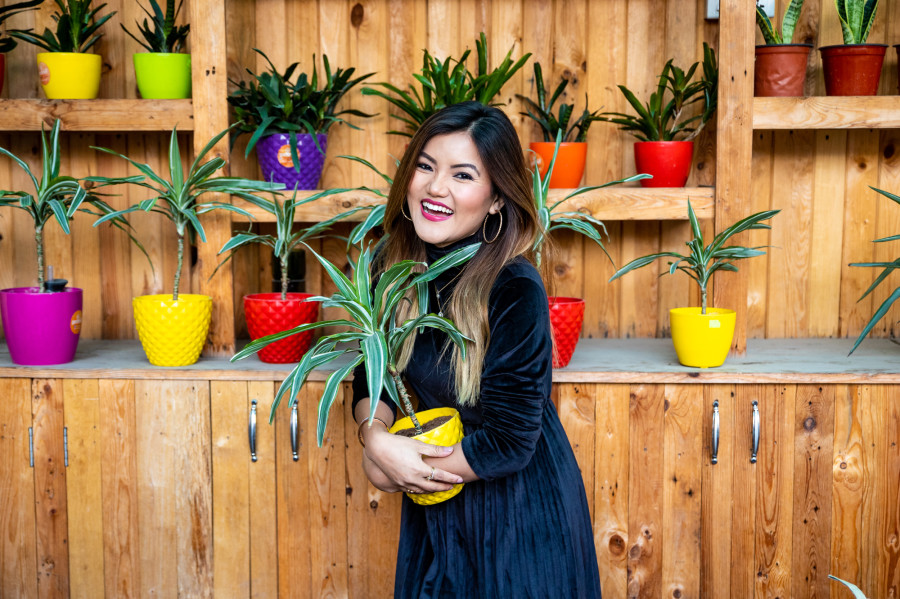Weekender
Eat. Sleep. Water. Repeat
The obsession with which the youth are turning to plant parenting could be because unlike parenting other living things like pets, parenting plants require less attention but provide the same opportunity to nurture and see them grow.
Kar Sangmo Dolma Syangtan
“My workspace is an extended garden for me,” says Maya Ghale from The Plant Shop at Gyanmandala in Jhamsikhel, who set up her shop in September 2018. When she speaks about her plants, she lights up and gushes about them as a mother would speaking about her children. “It’s akin to meditation for me—being responsible for and nurturing my plants,” she says, “I’m cool as a cucumber parenting them.”
Maya’s words tell one of what most city residents feel—as though the surface has swelled up (again) and the corners of the city are pushing against each other. In this ever-shrinking city, plants come as a blessing to minimise the constricting void for most like Maya.
The love of houseplants has much to do with self-care and wellness movements that the younger generation is very much a part of. Since the millennials are big on fitness classes to healthy eating, it makes perfect sense for them to fully embrace the physical and mental health benefits offered by keeping plants.
Maybe that’s why over the last few years, the millennial’s love for houseplants has grown steadfast. Also, fuelling the love affair behind the scenes is social media with ‘plant parenthood’ entering the lexicon as a legitimate term thanks to the visually-driven popularity, especially on Instagram.
The surge in the trend is here to stay as there are more than 145k posts on #plantparent on Instagram and ‘plantfluencers’ seeing a daily followers’ rise.
However, for Nirjala Maharjan, an architect, the compelling reason for plant collecting was not backed by social media popularity. She was a student of Architecture who had to do an assignment on indoor plants for her class project. “That’s when I learned about the benefits of plant parenting. The plant community in Nepal existed long before plant parenthood became a global trend,” says Nirjala.
“I stay in touch with fellow plant parents; we share tips and recommend new plants to one another.”
For Renasha Bantawa Rai, choreographer and director, her plant parenting journey tells a different story. “I can’t say for sure when my love affair with plants started. But I come from eastern Nepal where every house is filled with plants both outdoors and indoors. Maybe that’s where my love for plants comes from.”
Worldwide, plant parenting has taken a bigger definition with plant parents vying for the next big thing. Like with any other collectors; plant enthusiasts feel the need to have the rarest, the most elusive, the most expensive plant in their collection. “But in Nepal, young plant parents are starting with something that’s easy to look after and usually go for succulents,” says Biraj Khadka, whose team initiated I Am Gardener in 2016.
“In Nepal, the plant industry saw an influx of customers for houseplants toward the end of 2017 and by the end of 2018, the industry had boomed,” says Biraj. “More than 50 percent of our clientele are youngsters.”
The obsession with which the youth are turning to plant parenting could be because unlike parenting other living things like pets, parenting plants require less attention but provide the same opportunity to nurture and see them grow.
At Maya’s, her young customers ask for perennials like cacti since they are relatively low-maintenance. The same is true at Biraj’s but “a more mature population of 25-35 are seen preferring tropical, evergreen plants, advancing further to orchids and new exotic plants,” he says.
For those who are just starting on the journey of plant parenting, it’s imperative to realise your own capacity to look after your plant baby. Keeping what functional type the plant is in mind bolsters the odds of not killing them since not everybody has green fingers. “It is essential to consider how much time and commitment one can dedicate to the plants. Basics like providing natural light to your plants should not be overlooked,” says Maya, “One of the most prevalent problems is overwatering. It rots the root unseen from above, so when the deterioration finally reaches the stem and leaves, the plant is done for.”
For absolute beginners, succulents and seasonal plants for foliage are highly recommended. Monstera, Bonasera, and Pothos, commonly known as money-plant are some of the plants to begin plant parenting with. “Tropical plants are rare in Nepal. Calathea, also known as the Prayer Plant (as it folds up the leaves during the night, has fascinating foliage colours and striking patterns) is one of the most unique plants I’ve come across,” says Nirjala.
Whatever escape route the youths take from a world that is getting increasingly clustered yet equally distant, taking on a love affair with houseplants is a healthy choice. It encourages patience and self-care and also fosters community in a world where people can feel otherwise alone. So, initiate a love affair, fall in love with nature, nurture and new beginnings.




 22.65°C Kathmandu
22.65°C Kathmandu










